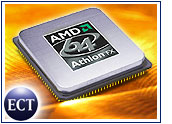
Computer chip challenger AMD unveiled a new family of value processors this week, named Sempron, aiming for the budget desktop and notebook markets that are growing worldwide, and also to allow its Athlon processors to serve higher-end markets.
The Sunnyvale, California, company said the processors are being made for “day-to-day needs of home and business PC users,” adding that basic computing is no longer limited to e-mail, Web browsing and word processing but now includes downloading and playing music, sending pictures to family and other more processor-intensive activities.
The company offered few details about the new Semprons, but said it will be divulging more details and will begin shipping the budget processors during the second half of the year. Mercury Research president Dean McCarron said it was difficult to speculate without knowing clock speeds or other technical information, but pointed out that the Semprons are AMD’s latest value processor brand.
“They really needed something to serve the low-cost market without dragging down Athlon,” McCarron told TechNewsWorld. “It will probably be some sort of cost-effective version of an existing processor, perhaps with less bus speed or less cache.”
Change In Name or Game?
AMD vice president of the microprocessor business unit Marty Seyer said the Semprons will be a response to evolving customer needs, adding that his company is “changing the name of the game for everyday computing” with the new brand.
McCarron said the Semprons represented more of a change for AMD itself, because it will free its higher-performance, higher-priced chips from serving the low-end market as well as fill a gap left by its previous Duron value line.
“Basically, for about the last year, AMD has had Athlon serving double duty in both the more mainstream segment where people are willing to pay more and the low-cost market, where products are purchased on price,” McCarron said.
Outside White Box
Aberdeen Group chief research officer Peter Kastner said there might not be increasing budget market demand in the United States, but in other parts of the world such as Thailand or Maylaysia, the so-called white-box market represents 40 percent of available sales.
“To compete with the very low-end systems, AMD needs a mature and inexpensive processor because cost is more important in that market,” Kastner told TechNewsWorld.
Although AMD has put its Athlon XP in the low-end market for years, it is not necessarily the right fit for the processor that has been most successful in the enterprise.
“The bigger picture is AMD’s gotten a lot of credibility this year with the Athlon 64s,” he said. “Those are much more profitable than the cheap chips.”
Low-End Value
While it is often referred to as the “value” market but could easily be called the “cheap” market, the low-end market still represents “not half, but more than a third” of the overall chip space, McCarron said.
“That’s not a business you walk away from,” he said.
Matching up against Intel’s Celeron, analysts indicated that the Semprons will likely be capable processors because AMD’s Athlon line can “hold its own against processors in Intel’s space,” as McCarron put it.
“Sempron allows AMD to disconnect Athlon from the low end and serves an important role in terms of market position,” McCarron added. “This is about managing their product lines and keeping their product pricing in line.”





















































